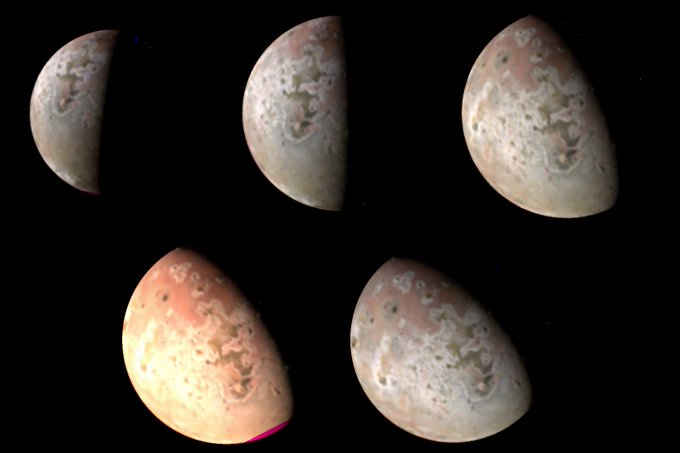On March 1, 2023, NASA’s Juno spacecraft flew by Jupiter’s moon Io, coming within 51,500 km (32,030 miles) of the innermost and third-largest of the four Galilean moons. The stunning new images provide the best and closest view of the most volcanic moon in our Solar System since the New Horizons mission flew past Io and the Jupiter system in 2006 on its way to Pluto.
Cleary, Io still looks like a pizza. The mottled and colorful surface comes from the volcanic activity, with hundreds of vents and calderas on the surface that create a variety of features. Volcanic plumes and lava flows across the surface show up in all sorts of colors, from red and yellow to orange and black. Some of the lava “rivers” stretch for hundreds of kilometers.

Jupiter’s moon Io, as seen by the JunoCam instrument on Juno, on March 1, 2023. Credit: NASA/JPL-Caltech/SwRI/MSSS/ processed by Kevin M. Gill.
In its extended mission, Juno has now orbited Jupiter 49 times, and is on course to study several of Jupiter’s moons. This latest flyby of Io was the third of nine flybys of the volcanic moon over the next year, with the first coming in December of 2022. An upcoming flyby next year on February 3, 2024 will come as close as 1,500 km (930 miles) from Io.
Montage of all 5 images of Io taken by @NASAJuno's JunoCAM instrument during the PJ49 encounter on March 1, 2023.
Credit: NASA / SwRI / MSSS / Jason Perry pic.twitter.com/o2G7DUASbd
— Jason Perry (@volcanopele) March 4, 2023
Jason Perry, an Io observation expert who has worked with the Cassini, Galileo and HiRISE imaging teams said on Twitter that his first looks at these images show some subtle changes from the New Horizons images.
“Surface changes are pretty subtle but there are at least two,” Perry wrote. “The first is a small flow from the eastern end of East Girru. This is a [volcanic] hotspot first seen by New Horizons in the middle of a mini outburst. Still active according to Juno JIRAM.”
The Jovian InfraRed Auroral Mapper (JIRAM) is a dual instrument, composed of an imager and a spectrometer that share the same telescope.
Perry said other data shows a reddening of Chors Patera, a bowl-shaped volcanic crater. “Reddish material on Io indicates the presence of S3-S4, short-chained sulfur that have to be refreshed regularly through active, high-temperature volcanism,” he explained.
🧵1/n
Io, a World around Jupiter a few hours agoFull size Video: https://t.co/QtOexIBOY9
Orbit (Perijove) 49@NASAJuno
Alt: 64994 to 52515 km
Time: 2023-03-01
JNCE_2023060_49C00074>78#Space #Astronomy #Jupiter #Io
NASA/JPL-Caltech/SwRI/MSSS /AndreaLuck https://t.co/OPyD42aNzf pic.twitter.com/R7NYyhDaIA— Andrea Luck (@andrluck) March 4, 2023
JunoCam is a high-resolution visible light instrument, which is actually not part of the spacecraft’s primary scientific payload. It was included in the mission as a public outreach camera, and its images are processed by members of the public, many who have been actively processing Juno’s images since it reached Jupiter in 2016. However, with the plethora of JunoCam images, it’s turned out that the imagery has also been used for science, too.
Source: universetoday.com






